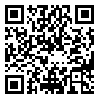شمارۀ جدید فصلنامه (پاییز1404) منتشر شد
Volume 11, Issue 2 (10-2020)
Social Problems of Iran 2020, 11(2): 33-64 |
Back to browse issues page
Download citation:
BibTeX | RIS | EndNote | Medlars | ProCite | Reference Manager | RefWorks
Send citation to:



BibTeX | RIS | EndNote | Medlars | ProCite | Reference Manager | RefWorks
Send citation to:
Bagheri M, Sedigh Ouraee G, Farzaneh A. (2020). Problem of Social Interaction in the Iranian Family. Social Problems of Iran. 11(2), 33-64.
URL: http://jspi.khu.ac.ir/article-1-3283-en.html
URL: http://jspi.khu.ac.ir/article-1-3283-en.html
1- PhD student in Economic Sociology and Development, Ferdowsi University of Mashhad
2- Assistant Professor of Sociology, Ferdowsi University of Mashhad ,sedighouraee@um.ac.ir
3- PhD student in Cultural Sociology, Hozeh Research Institute and Qom University
2- Assistant Professor of Sociology, Ferdowsi University of Mashhad ,
3- PhD student in Cultural Sociology, Hozeh Research Institute and Qom University
Abstract: (3497 Views)
Human need social life and the foundation of social life is the continuous interaction with other people. The consistency and durability and efficiency of continuous interaction depends on continuous Warm interaction (In two form Warm equal and warm unequal). Family interaction is an important area of warm interaction and the family is the last refuge of individuals in society. But a lot of research shows that the family is also extremely and broadly has a manifest and painful illness. The purpose of this article is to describe the state of social interaction in family in Iran -as sociologists have perceived and reported. The present research has cited 81 credible articles conducted by 39 important Iranian sociologists. In this research, based on the Directed content- analysis method, the social interaction state in family in Iran was extracted. The data show that: “problem of Lack of social relation and interactions in the family, Shortage And reducing family interactions, Shortage Warm interactions in the family, Existence Cold interactions in the family, Break up the spouse relationship, Inappropriate family social capital and the shortage Family Trust” Each of these problems includes more minor interactive problems which shows that our latest social sanctuary is also extremely “Low-grade” and ill.
Type of Article: Original Research |
Received: 2020/07/28 | Accepted: 2021/03/8 | Published: 2021/03/14
Received: 2020/07/28 | Accepted: 2021/03/8 | Published: 2021/03/14
References
1. Asgharpour Masouleh, A., Seddigh Ouraee, G., & Kermani, M. (2018). Explaining Men's Discord Actions in Iranian Families. Social Sciences, Faculty of Literature and Humanities, Ferdowsi University of Mashhad(14), 1-30.
2. Nodoushan, A., & Tavassoli, G. (2011). Social Causes of Divorce in Yazd Province in the Past Decade. Iranian Social Development Studies, 4(3), 35-50.
3. Abbasi, K., & Ershad , F. (2012). A Survey on the effect of socio-cultural and psychological factors on marital unadjustment in shoushtar during 2010. Woman & Study of Family, 15(4), 127-148.
4. Aliverdinia , A., Hasani, M., & Ebrahimi , E. (2014). Family Factors of Child Abuse. Social Welfare Quarterly, 50(13), 71-110.
5. Bakhshi, H. (2013). Public poll on the preserve, strengthen the spirit of self-sacrifice and the Provide strategies to promote the spirit of self-sacrifice. Mashhad: Jahad Daneshgahi of Mashhad.
6. Bastani, S., Golzari, m., & Rowshani, . (2010). EMOTIONAL DIVORCE: Causes and Mediating conditions. Iranian Journal of Social problem, 3(1), 1-20.
7. Boudon, R., & Borico, F. (2006). A Critical dictionary of sociology. (A. Nikgohar, Trans.) Tehran: farhangmoaser.
8. Bourdieu, P. (2010). Forms of capital. In Social capital: trust, democracy and development (A. Khakbaz, & H. Pouyan, Trans., pp. 131-165). Tehran: Shirazeh.
9. Chalabi, M. (2002). Experimental Study of Personality System in Iran. Tehran: nashreney.
10. Chalabi, M., & Rouzbahani , T. (2001). Family role as a factor to prevent misdemeanor in young adults (with an emphasis on family order). Journal of Human Sciences, 95-132.
11. Coser, L., & Rosenberg, B. (2006). Sociological theory: a book of reading. (F. Ershad, Trans.) Tehran: nashreney.
12. Fathi , M., Satar, P., & Javadian, S. (2017). Comparing the causes of infidelity in marital relationships among men and women: a qualitative research. Journal of qualitative research in health sciences, 5(4), 401-418.
13. Ghaffari, G. (2015). Measuring the social capital of the country. Tehran: National plan: Research Center of Culture, Arts and Communications.
14. Ghasemi, A., & Saroukhani, B. (2014). Social factors of divorce and psycho-social health in couples seeking consensual and non-consensual divorce. The Women and Families Cultural-Educational Journal, 26(8), 7-37.
15. gitipasand, z., farahbaksh, k., asmaeili , m., & zakaei, m. (2015). Meaning of Life in Divorce Volunteer Couples. Journal of Family Counseling and Psychotherapy, 2(5), 50-79.
16. Golchin, M., & Heidari, A. (2012). Interpersonal violence and family and school social capital: a social assessment of Nour Abad boys high schools (lorestan province). Social problems of Iran, 1(3), 177-212.
17. Golchin, M., & Heidari, A. (2015). Sociological study of disruptive behaviors (vandalism) and its relationship to social capital in family and male high school in the city of Lorestan Nurabad. Social Sciences, Islamic Azad University - Shushtar Branch, 8(2), 75-110.
18. Hasanpoor azghadi, B., Simbar, M., & Kermani, M. (2011). Domestic violence against women: review of theories, prevalence and its effective factors. Advances in nursing and midwifery (faculty of nursing of midwifery quarterly), 21, 44-52.
19. iman, m., & Noshadi, M. (2011). Qualitative content analysis. Pazhuhesh, 3, 15-44.
20. Jafarian, T., Fathi, M., Arshi, M., & Ghaderi, R. (2016). The Efferct of Men's Emotional Intelligence on Violence against women among couple married. Knowledge & Research in Applied Psychology, 16(62), 76 -83.
21. javaheri, f., & Helali Sotoudeh, M. (2016). tendency to Solo living. In G. Ghaffari, & M. Javadi Yeganeh (Eds.), Articles on Social Situations of the Country (pp. 171-210). Tehran: Social Council of the country :Institute for Social and Cultural Studies of the Ministry of Science, Research and Technology.
22. Kalantari , A., Roshanfekr, P., & Javaheri, J. (2011). Three Decades of Researches about "Divorce Causes" in Iran: A Review. Women's Strategic Studies, 53(14), 129-162.
23. Khairkhahzadeh, S., & Sadeghi Fasaei, S. (2012). A Survey of Men's Perceptions of Domestic Violence Against Them in Iran. Iranian Journal of Social Problem, 2(2), 107-154.
24. Maghsodi, S., Moidfar , S., & Tavakol, M. (2011). Sociological Study of Social Capital and marital satisfaction among couples in Kerman. Iranian Social Studies, 1(5), 124-152.
25. Mohseni Tabrizi, A. (2002). Pathology of socio-cultural alienation. Quarterly Journal of Research and Planning in Higher Education, 26(8), 119-181.
26. Mohseni Tabrizi, A., Amani Sandiani, F., & Dousti , A. (2010). A sociological survey about sexual inequality and its role in emergence of violence (A case study of Tehran). Contemporary Sociological Research, 3(1), 5-27.
27. Moidfar, s., & Sabouri Khosrowshahi, H. (2011). Conflict in lifestyle between children and parents. Social development and welfare planning, 7(3), 67-97.
28. momeni rad , a., Ali Abadi, K., Faradanesh, H., & Mazini, N. (2012). Qualitative content analysis in research tradition: nature, stages and validity of the results. Educational measurement, 14, 187-222.
29. Ogburn, W. F., & Nimkoff, M. (1974). Socilogy. (A. Aryanpour, Trans.) Tehran: Franklin Book Program.
30. Pishkar, S., & Zahedi ask, M. (2013). THE STUDY OF RELATION BETWEEN THE FAMILY FUNCTION AND ESCAPE OF THE GIRLS FROM HOME (COMPARISON OF TWO GROUPS; RUNAWAY 7 RUNAWAY GIRLS). SOCIAL RESEARCH, 17(4), 91-112.
31. Pournasiri, S., Roustakhiz, B., & Boustani, D. (2018). Qualitative Investigation of Adaptive Divorce: Case Study of Talesh Males During 2014. Journal of Social Development, 12(2), 143 -172.
32. Rafat Jah , M., & Bahrami, S. (2011). Anthropological study of family disorders in Sirus neighborhood of Tehran. Iranian Journal of Anthropology Research, 2(1), 85-110.
33. Rahimi, M., shekarbeugi , A., saroukhani , B., & Hazrati somee, Z. (2017). Sociological study of the relationship between virtual social networks and current changes in couples marriages in a Tehran city. The Islamic Journal of Women and Family, 8(5), 145-169.
34. Rocher, G. (2012). Talcott Parsons and American sociology. (A. Nikgohar, Trans.) Tehran: nashreney.
35. Sarokhani, B., Nazari, F., & Vosoughi , M. (2017). A Sociological study of the relationship between social trust and human communication, emphasizing families of Tehran city in the years 1393 to 1395. Urban studies, 7, 1-30.
36. Saroukhani, B., & Ghasemi, A. (2013). A Sociological Study of the Factors Influencing the Increase of Uncontested Divorce in Kermanshah City. The Women and Families Cultural-Educational Journal(7), 7-49.
37. Seddigh Ouraee, G. (2014). A series of symposiums between the Hawzeh and University: Low-grade and Runaway from religion. Islamic Studies in the Humanities (Ferdowsi University of Mashhad) (p. Meeting 139). Mashhad: Islamic Studies in the Humanities (Ferdowsi University of Mashhad).
38. Seddigh Ouraee, G. (2017). Ways to promote social trust. Islamic Studies in the Humanities (Ferdowsi University of Mashhad) (pp. 1-25). Mashhad: Islamic Studies in the Humanities (Ferdowsi University of Mashhad).
39. Seddigh Ouraee, G., & Asgharpour Masouleh, A. (2009). Value disagreement and its effect on couple incompatibility in Mashhad. Iranian Social Studies, 3(3), 49-71.
40. Seddigh Ouraee, G., & Farzaneh, A. (2016). Iranian loneliness. In R. Javadi, Research in social capital in Iran (pp. 97-107). Tehran: Research Center of Culture, Arts and Communications.
41. Seddigh ouraee, G., Farzaneh, A., Bagheri, M., & Mohammadi , s. (2019). Principles of Sociology (Fundamental concepts and Propositions). Qom: Research Institute of Hawzeh and University.
42. Sharepour, M., Fattahi, S., Zanjan Rafiee, N., & Rafiee Atani, F. (2016). The weakness of socialization with an emphasis on childhood. In G. Ghaffari, & M. Javadi Yeganeh (Eds.), Articles on Social Situations of the Country (pp. 41-97). Tehran: Social Council of the country :Institute for Social and Cultural Studies of the Ministry of Science, Research and Technology.
Send email to the article author
| Rights and permissions | |
 |
This work is licensed under a Creative Commons Attribution-NonCommercial 4.0 International License. |







